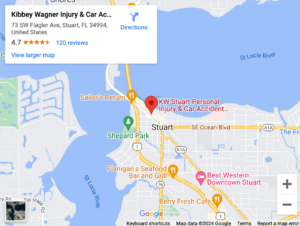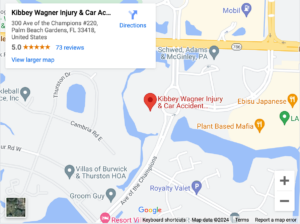
Suffering an injury because of a slip and fall accident, car accident, medical malpractice, or other negligent act or intentional wrongdoing causes damages. Damages can include monetary losses and pain and suffering. Florida personal injury laws allow injured parties to seek compensation for these damages by filing a personal injury claim or lawsuit.
A personal injury lawyer works with you to obtain maximum compensation for damages, including pain and suffering damages. We fight to hold the party responsible for your injuries liable for the damage they caused.
What Damages Can I Recover for an Accident or Personal Injury in Florida?
Florida permits injured parties to seek compensation for their economic and non-economic damages. In a few personal injury cases, the court could award punitive damages.
Examples of economic damages include:
- Medical expenses and bills
- Nursing care and personal care
- Out-of-pocket expenses
- Loss of income and benefits
- Physical therapy and other rehabilitative therapies
- Diminished earning potential
Financial losses are only one type of damages. Victims can also recover compensation for pain and suffering damages. These non-economic damages include:
- Physical pain
- Emotional distress
- Mental anguish
- Scarring and disfigurement
- Loss of enjoyment of life
- Permanent impairments and disabling conditions
- Decrease in quality of life
Damages for pain and suffering can also include diagnosable conditions that result from the trauma of being injured. They include depression, PTSD, anxiety, and other disorders. A victim can also claim compensation for embarrassment, inconvenience, and grief.
How Much Are Pain and Suffering Damages Worth for a Personal Injury?
Calculating pain and suffering damages can be challenging. There is no standard formula or statutory rule for placing a value on someone’s suffering and pain.
Insurance companies try to use pain and suffering calculators to estimate the value of these damages. However, insurance companies consistently undervalue damages. They downplay the impact of pain and suffering damages.
Beware of using online pain and suffering calculators or calculators for determining how much a personal injury case is worth. These calculators are not accurate. They fail to consider the specific factors that impact the value of pain and suffering damages.
Factors that impact how much you could receive for your pain and suffering damages include, but are not limited to:
- The type and severity of your injury
- How long it takes you to recover from your injuries
- Whether you sustained permanent disabilities and impairments
- The extent of disfigurement and scarring caused by the injury
- The strength of the evidence proving fault and liability
- Whether you were partially to blame for the cause of your injury
- Availability of insurance coverage and the willingness of the insurance company to negotiate a fair settlement
Before accepting a pain and suffering settlement offer from an insurance company, talk with an experienced attorney. They can review the settlement offer to advise whether the company is making a good faith offer or undervaluing damages.
Using the Multiplier Method to Calculate Pain and Suffering Damages
Putting a price on your pain and suffering can seem impossible. However, the law cannot undo your suffering. Therefore, it allows you to seek monetary compensation from the party who caused your injuries.
The multiplier method is the most common pain and suffering calculator used to determine the value of non-economic damages. Using the facts and circumstances of the case, the parties agree on a multiplier between 1.5 and five.
Cases involving catastrophic injuries, permanent impairments, and other devastating conditions justify a higher multiplier. The insurance company will always argue for the lowest multiplier.
To calculate pain and suffering damages, you multiply the number by the dollar amount of your economic damages. The result is the value of your non-economic damages. Therefore, the amount of your financial losses directly impacts the value of pain and suffering.
An Alternative: The Per Diem Method
The parties could also assign a per diem to place a value on non-economic damages. A per diem is a dollar amount the insurance company agrees to pay you per day for your suffering.
The per diem is multiplied by the number of days between the accident date and your recovery date. The recovery date is either when your doctor releases you or your doctor states you reached maximum medical recovery.
How Do I Prove Pain and Suffering Damages?
Pain and suffering damages are more difficult to prove than economic damages. These damages are subjective because everyone reacts differently to injuries and accident trauma.
Because there are no invoices or bills stating the amount of pain and suffering, we use other evidence. Examples of evidence used to prove the extent of your suffering include:
- Photographs of your injuries
- Medical records and statements from physicians, physical therapists, and occupational therapists
- Your personal testimony regarding your pain and suffering
- Opinions from medical experts explaining how the type of injury can impact a person physically, mentally, and emotionally
- Testimony from family members and friends explaining how your injuries impacted your daily life and relationships
- Medical records from counselors, therapists, and other mental health care providers
Writing a pain and suffering journal can be very helpful in proving the extent of your damages. It can be difficult to remember details of your recovery. Having a journal helps your lawyer develop a compelling explanation of the extent of your suffering.
Your journal should include details of your recovery, such as your daily pain levels. You could include details about the activities you could not perform and how the injury impacted your personal relationships. Providing honest, accurate, and detailed information can improve your chance of receiving maximum compensation for your injury claim.
Details help jurors “feel” the pain you experienced after an accident or personal injury. For example, explain that you experienced sharp, stabbing pains each time you took a deep breath for months after a chest injury. Then, describe how that pain impacted you physically and mentally.
Should I Deal Directly With the Insurance Company?
It is best to refer the insurance company and claims adjuster to your personal injury attorney. Talking to an insurance adjuster or investigator could hurt your case. Remember, their job is to gather evidence to lower the value of your claim.
Therefore, what you say is very important. An answer to a question could be intentionally misinterpreted. Details you disclose could be used against you.
It is best to let your lawyer handle all communications with the insurance company. It prevents the insurance company from taking comments out of context when valuing your pain and suffering damages.
Call Our Office for a Free Consultation With a Stuart Personal Injury Lawyer
Our legal team is ready to help you recover the compensation you deserve for a personal injury or accident. Contact our law firm to schedule your free consultation with an experienced personal injury lawyer in Stuart, FL. Call us at (772) 444-7000 today.




